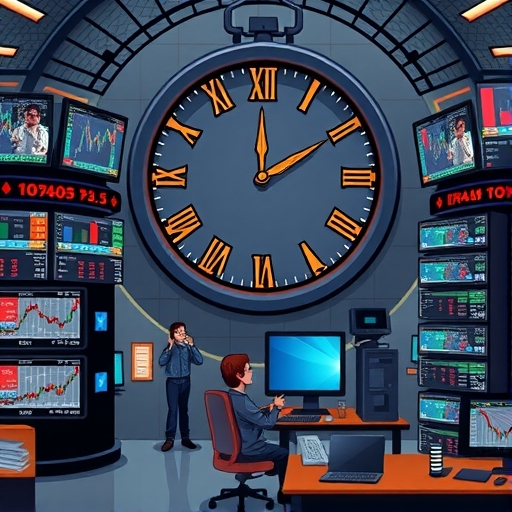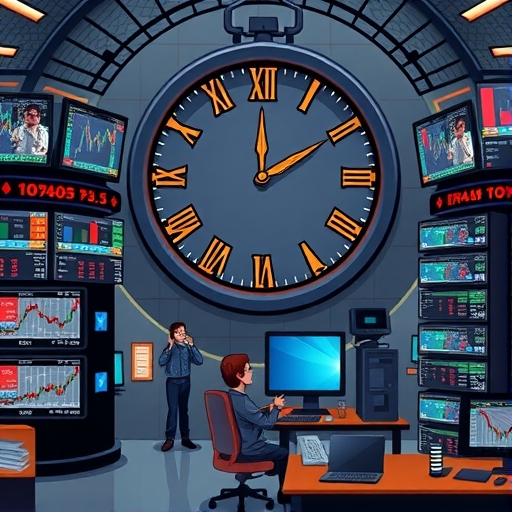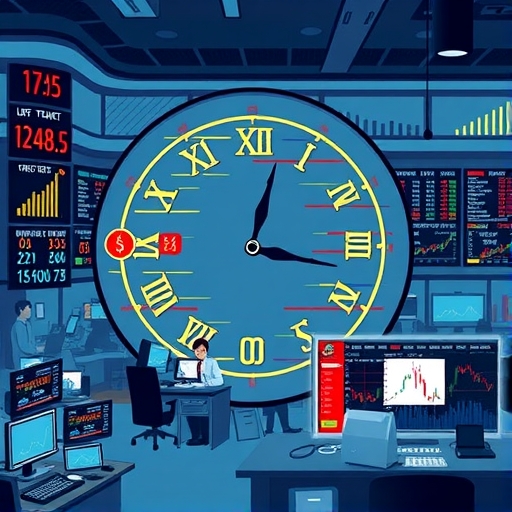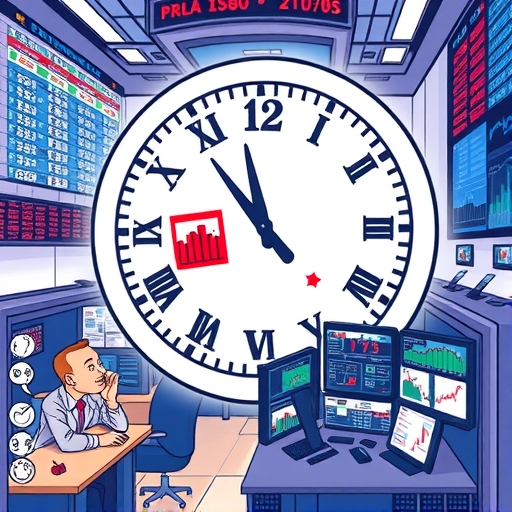
What Time Does the Stock Market Open: Master Trading Hours Like a Pro
Table of Contents
ToggleUnderstanding US Stock Market Hours: From Opening Bell to After-Hours and Beyond
Investing in the stock market can feel like learning a new language, with its own vocabulary, rules, and perhaps most importantly, its own rhythm. For anyone looking to trade stocks, whether you’re just starting out or seeking to refine your technical analysis, understanding *when* the market is open is absolutely fundamental. It’s not just about knowing the official start and end times; it’s about appreciating the nuances of extended trading sessions, holiday schedules, and the dynamic forces that influence prices minute-by-minute within these windows.
Think of the stock market as a vast, global marketplace with specific operating hours. Just as a physical store has its opening and closing times, major stock exchanges adhere to a defined schedule. But unlike a typical store, activity doesn’t always cease when the main doors close. There are periods of intense activity before the official open and after the official close, each with its own characteristics and risks.
In this article, we will walk through the standard operating hours for the major US stock exchanges, explore the concept of extended trading, delve into the less-discussed holiday and early closure schedules, and touch upon how external events constantly shape the trading landscape, regardless of the hour. Our goal is to equip you with a comprehensive understanding of the market’s timetable, helping you navigate its complexities with greater confidence.

For most investors in the United States, the primary focus is on two major exchanges: the New York Stock Exchange (NYSE) and the Nasdaq Stock Market. These are the behemoths where shares of countless publicly traded companies, from established giants to innovative tech firms, are bought and sold.
The standard operating schedule for both the NYSE and Nasdaq is quite consistent:
-
Monday through Friday
-
9:30 a.m. Eastern Time (ET) to 4:00 p.m. Eastern Time (ET)
This six-and-a-half-hour window represents the core trading day. It’s the period when the vast majority of trading volume occurs, liquidity is generally highest, and price discovery is most robust. If you are placing standard market orders or limit orders without specifying “good ’til cancelled” or other duration parameters, they are typically executed within this timeframe.
The start of the trading day at 9:30 a.m. ET is often marked by the symbolic “opening bell.” This ceremony, particularly at the NYSE, involves a dignitary or executive ringing a bell, signaling the official commencement of trading. Similarly, the end of the trading day at 4:00 p.m. ET is marked by the “closing bell.” These bells, while ceremonial, underscore the distinct start and end points of the main trading session.
Why these specific hours? The 9:30 to 4 schedule has historical roots, evolving over time from earlier, longer trading days. It largely aligns with traditional business hours and provides a balance between allowing sufficient time for trading and providing time for brokers, analysts, and exchange personnel to process trades and prepare for the next day. It’s also designed to overlap significantly with typical business hours across the US Eastern Time Zone, where many major financial institutions are headquartered.
The 4:00 p.m. ET closing bell doesn’t necessarily mean trading activity stops entirely. In today’s interconnected, 24/7 news cycle world, market-moving information can drop at any time. To accommodate the need for investors and institutions to react to news outside of standard hours, exchanges offer extended trading sessions.
There are two primary types of extended hours trading for US stocks:
-
Pre-Market Trading: This occurs *before* the official 9:30 a.m. ET open.
-
After-Hours Trading: This occurs *after* the official 4:00 p.m. ET close.
The specific hours for these sessions can vary slightly depending on the exchange and the brokerage firm you use, as brokerages might limit client access to the full range of available hours. However, here are typical ranges you might encounter:
-
Nasdaq Pre-Market: Often runs from 4:00 a.m. ET to 9:30 a.m. ET.
-
Nasdaq After-Hours: Typically runs from 4:00 p.m. ET to 8:00 p.m. ET.
-
NYSE Umbrella Markets: Pre-opening sessions can start as early as 2:30 a.m. ET, with various pre-market and after-hours sessions extending to different times depending on the specific NYSE market (e.g., NYSE, NYSE American, NYSE Arca). After-hours can also extend to 8:00 p.m. ET.
These extended hours allow investors to react promptly to significant events, such as:
-
Company earnings reports released after the close.
-
Major economic data releases (like inflation figures or employment reports) that occur before the open.
-
Unexpected global geopolitical events or news developments happening overnight or in the late afternoon.
Trading in these sessions can be incredibly volatile, and it’s crucial to understand *how* this trading occurs and the risks involved.

Trading outside the standard 9:30 a.m. to 4:00 p.m. ET window doesn’t happen on the traditional exchange floor or through the main exchange systems in the same way. Instead, extended hours trading primarily takes place on Electronic Communication Networks (ECNs).
ECNs are automated systems that match buy and sell orders electronically. They were developed to facilitate trading outside standard hours and provide institutional investors and sophisticated traders with venues to transact based on information released when the main market is closed. When you place a trade during extended hours through your brokerage, it’s typically routed to one or more ECNs that your brokerage connects to.
A critical difference in extended hours trading is the prevalence of limit orders. Due to lower liquidity and potentially wider bid-ask spreads compared to regular hours, placing a market order (an order to buy or sell immediately at the best available price) can be risky. You might end up buying at a significantly higher price or selling at a significantly lower price than you intended because there are fewer buyers and sellers to absorb your order. A limit order, where you specify the maximum price you’re willing to pay (for a buy) or the minimum price you’re willing to accept (for a sell), provides you with more control over your execution price during these less liquid periods.
Your brokerage firm will have specific rules regarding extended hours trading, including the types of orders accepted (often only limit orders), the specific times they offer access, and potential disclaimers about the associated risks. It’s essential to familiarize yourself with your broker’s policies before attempting to trade in pre-market or after-hours sessions.
Extended trading hours are not just an academic concept; they are where market participants first react in a tangible way to new information. Think about a company scheduled to release its quarterly earnings report *after* the market closes at 4:00 p.m. ET. As soon as that report hits the wires, analysts, institutional investors, and even retail traders who have access can start trading the stock in the after-hours session.
If the earnings report is significantly better or worse than expected, the stock price can make a dramatic move in after-hours trading *before* the next day’s official open. This price movement in the extended session acts as an early indicator of market sentiment regarding the news. Similarly, important economic data released at 8:30 a.m. ET, before the 9:30 a.m. ET open, will immediately impact stock futures prices and potentially trigger significant activity in the pre-market session for individual stocks.

Understanding this mechanism is vital because the price at which a stock closes at 4:00 p.m. ET might be very different from the price it opens at 9:30 a.m. ET the next day, especially if major news occurred overnight. This difference is known as a “gap” in the price chart. Recognizing that pre-market and after-hours trading facilitate these gaps based on new information is key to interpreting charts and planning your trades.
While the Monday-Friday schedule is the norm, the US stock market observes several holidays throughout the year, on which trading is closed. These typically include major federal holidays like New Year’s Day, Martin Luther King, Jr. Day, Presidents’ Day, Memorial Day, Juneteenth National Independence Day, Independence Day, Labor Day, Thanksgiving Day, and Christmas Day.
However, there are also specific instances of early closures. These often occur on days adjacent to major holidays. The provided data highlights planned early closures at 1:00 p.m. ET (1:15 p.m. ET for eligible options) on the following dates for NYSE and Nasdaq:
-
July 3rd (when Independence Day, July 4th, falls on a Saturday or Sunday, leading to a Friday or Monday holiday observance, respectively)
-
The Day After Thanksgiving (often referred to as “Black Friday”)
-
Christmas Eve (December 24th)
| Date | Event |
|---|---|
| July 3rd | Early Closure |
| The Day After Thanksgiving | Early Closure |
| Christmas Eve | Early Closure |
For example, the data indicates these early closures are specifically scheduled for dates like July 3rd, the Day After Thanksgiving, and Christmas Eve in 2025, 2026, and 2027. On these days, the trading session is significantly shortened. While standard stock trading ends at 1:00 p.m. ET, certain specific late trading sessions on NYSE umbrella markets (like NYSE American Equities, NYSE Arca Equities, NYSE National, and NYSE Texas) might continue until 5:00 p.m. ET.
These early closure days require particular attention. Trading volume can often be lower and more volatile as the shortened day progresses and participants close out positions early. Being aware of these scheduled changes is crucial for planning your trading activity and avoiding unexpected market halts.
It’s helpful to remember that not all financial markets operate on the same schedule as US stocks. The trading hours are often dictated by the nature of the asset being traded, the global participation level, and the underlying infrastructure.
For instance, the US bond market typically operates on a slightly different schedule than stocks. While there are variations depending on the specific type of bond and trading platform, a common timeframe for government and corporate bond trading is from 8:00 a.m. ET to 5:00 p.m. ET. The bond market also has its own set of holiday closures, which may or may not perfectly align with stock market holidays.
Commodities futures, covering everything from oil and gold to agricultural products, trade for much longer periods. Markets like the CME Group’s exchanges often see trading sessions that are nearly 24 hours a day, six days a week, pausing only for short maintenance periods and weekend breaks. This extended accessibility is necessary because these are global commodities, and news or supply/demand shifts can occur at any hour across different time zones.
Perhaps the most striking contrast comes from the cryptocurrency markets. Assets like Bitcoin trade on exchanges globally and operate 24 hours a day, 7 days a week, 365 days a year. There are no opening or closing bells, no standard holidays, and no scheduled pauses except for potential exchange maintenance or specific network events. This continuous trading presents unique opportunities and challenges, including the potential for significant price swings at any time.
Understanding these differences is key if you plan to diversify your trading beyond US stocks. Each asset class has its own rhythm, influenced by its specific market structure and the global nature of its trading base.
If you’re exploring trading different asset classes, including stocks, commodities, or even venturing into currencies, choosing the right platform is essential. If you’re considering trading forex or other CFD instruments alongside stocks, Moneta Markets is a platform worth exploring. It offers access to over 1000 financial instruments and provides flexible trading platforms like MT4, MT5, and Pro Trader, catering to both beginners and experienced traders.
Knowing the market hours is only part of the equation. What happens *within* those hours is constantly influenced by a barrage of external factors. The data provided highlights how market sentiment and stock futures can be pointing higher or lower *before* the official open, largely driven by overnight news.
Geopolitical events, such as the Israel-Iran conflict mentioned in the data, can significantly impact market psychology and specific sectors (like defense stocks or energy). Reports of potential de-escalation or heightened tensions directly influence futures markets before the open and set the tone for trading throughout the day. This can cause market-wide risk-on or risk-off sentiment, affecting major indices like the Dow, S&P 500, and Nasdaq Composite.
Major economic announcements are equally impactful. Anticipation of a Federal Reserve interest-rate decision, for example, can cause markets to tread water or make significant moves as the decision approaches. The actual announcement and the subsequent press conference are closely watched events that can trigger immediate volatility and trend changes within the trading day. Other economic data, like inflation reports, employment figures, or GDP growth, also cause sharp reactions during the hours they are released.
Furthermore, government policy decisions, trade negotiations (like the potential US-EU tariffs referenced), and actions by regulatory bodies can all introduce uncertainty or create opportunities that influence trading activity and price levels throughout the standard and extended trading hours. Staying informed about these macro forces is just as important as tracking company-specific news.
Let’s look at a few examples from the provided data to illustrate how news interacts with market hours, particularly the influence visible *before* the main open:
| Company | News Impact |
|---|---|
| Sarepta Therapeutics (SRPT) | Shares plunged significantly after a report indicated a second patient death in a trial. |
| EchoStar (SATS) | Shares soared on news of President Trump meeting with FCC officials. |
| Roku (ROKU) | Stock surged on a reported partnership with Amazon Ads. |
These examples show that while the official trading day is 9:30-4, the forces that *determine* the day’s opening price and trajectory are often at play well before the opening bell, driven by information hitting the market around the clock.
Trading during the standard 9:30 a.m. to 4:00 p.m. ET session is generally considered less risky than trading in extended hours, primarily due to differences in liquidity and volatility.
-
Liquidity: During standard hours, millions of shares are traded every minute. There are many buyers and sellers, making it easy to enter or exit a position close to the current market price. In extended hours, trading volume is significantly lower. Fewer participants mean fewer buyers and sellers available at any given price point. This can result in wider bid-ask spreads and the risk of significant price movements on relatively small trades – a phenomenon known as “thin trading.”
-
Volatility: Lower liquidity in extended hours often leads to higher volatility. Prices can swing more dramatically on limited volume, especially when reacting to a single piece of news. While this offers potential for quick gains, it also increases the risk of rapid and unfavorable price changes.
-
Price Discovery: The true consensus price of a stock is best determined when the most market participants are active, which is during standard hours. Prices in extended sessions, based on lower volume and potentially less complete information flow, might not accurately reflect where the stock will trade once the full market opens. The price you trade at in pre-market could be very different from the price minutes or hours later.
-
Order Execution: As mentioned, brokerages often restrict order types in extended hours, typically only allowing limit orders. While limit orders offer price control, there’s no guarantee they will be filled if the price doesn’t reach your specified limit within the low-volume environment. Market orders, if allowed, carry high risk of unfavorable execution prices.
Understanding these risks is paramount. Trading in extended hours is often best suited for experienced traders comfortable with higher volatility and lower liquidity. For beginners, focusing on the standard trading day where conditions are typically more stable and predictable is often advisable.
The market’s operating hours should directly influence your trading strategy and approach. How? Consider these points:
-
When to Place Orders: Do you place orders before the market opens, during the core session, or after the close? Placing orders outside standard hours means they’ll be exposed to extended hours volatility and potential gaps at the open. Placing them during standard hours generally offers better execution prices due to higher liquidity, but you might miss out on reacting instantly to overnight news.
-
Reacting to News: If you plan to trade based on news, you need to know when that news is likely to be released and how the market will react. Companies often announce earnings after the close (around 4:05 PM ET) or before the open (around 7:00-8:00 AM ET). Economic data has specific release times (e.g., 8:30 AM ET). Planning your reaction requires awareness of these schedules and the associated extended trading windows.
-
Risk Management: If you hold positions overnight, you are exposed to the risk of price gaps caused by after-hours or pre-market news. Understanding the potential for these gaps, influenced by events happening when you might not be actively monitoring the market, is a crucial part of overnight risk management.
-
Choosing Your Broker: As we discussed, different brokerage firms offer different levels of access to extended trading hours and various trading platforms. Your choice of broker can impact your ability to trade outside the standard 9:30-4 window. Some platforms might offer earlier pre-market access or later after-hours access than others.
Your personal schedule and risk tolerance should also factor in. If you have a full-time job during standard market hours, you might need to rely more on pre-market or after-hours trading, but you must do so with a full understanding of the increased risks. Alternatively, you might focus on strategies that don’t require constant minute-by-minute monitoring, like longer-term swing trading or investing.
When considering where to manage your investments and trades, particularly if you’re interested in diverse markets, evaluating brokerage platforms is key. If your interests extend to currency trading or various CFDs, finding a broker with a strong global presence and regulatory compliance is vital. Moneta Markets is one such platform that is regulated by entities like FSCA, ASIC, and FSA, offering segregated client funds and 24/7 support, which are crucial features for traders operating globally.
While our focus has been on US stock market hours, it’s worth noting that trading is a global, almost continuous activity when you consider exchanges around the world. When the US market closes, markets in Asia, Europe, and elsewhere are either opening or in full swing. Here’s a very brief look at some other major markets:
-
Asia: Tokyo Stock Exchange (TSE) and Shanghai Stock Exchange (SSE) have trading hours that occur overnight for those in the US (e.g., Tokyo’s standard session is roughly 8:00 p.m. to 2:00 a.m. ET).
-
Europe: Major European exchanges like those on Euronext (Amsterdam, Paris, etc.) and the London Stock Exchange operate during hours that overlap slightly with the US morning (roughly 3:00 a.m. to 11:00 a.m. ET for London).
-
Middle East: The Saudi Exchange, for instance, operates on a Sunday-Thursday schedule, given the weekend typically falls on Friday and Saturday in the region.
The trading activity in these global markets, influenced by their own regional news and economic data, can certainly impact US stock futures and the sentiment leading into the US market open. For advanced traders or those with global portfolios, monitoring key international markets is another layer of complexity.
Understanding what time the stock market opens and closes is far more than just knowing the 9:30 a.m. to 4:00 p.m. ET window for the NYSE and Nasdaq. It involves appreciating the significance of extended trading hours, recognizing the specific dates for holiday closures and early finishes, and understanding how global events and economic data released at any hour can influence market behavior both before and during the official session.
The market’s clock dictates the pace of trading, the availability of liquidity, and the potential for volatility. By becoming intimately familiar with this rhythm – from the ceremonial opening bell to the quiet hum of after-hours ECNs – you gain a significant advantage in planning your trades, managing your risk, and reacting effectively to the constant flow of information.
what time does the stock market openFAQ
Q:What time does the stock market open on weekdays?
A:The stock market opens at 9:30 a.m. ET on weekdays.
Q:Are there early closures for the stock market?
A:Yes, the stock market can close early on days before holidays.
Q:What is extended trading?
A:Extended trading refers to trading activity that occurs before the market opens and after it closes.
You may also like
Calendar
| 一 | 二 | 三 | 四 | 五 | 六 | 日 |
|---|---|---|---|---|---|---|
| 1 | 2 | 3 | 4 | 5 | 6 | 7 |
| 8 | 9 | 10 | 11 | 12 | 13 | 14 |
| 15 | 16 | 17 | 18 | 19 | 20 | 21 |
| 22 | 23 | 24 | 25 | 26 | 27 | 28 |
| 29 | 30 | 31 | ||||
發佈留言
很抱歉,必須登入網站才能發佈留言。